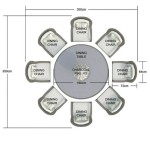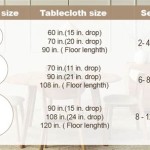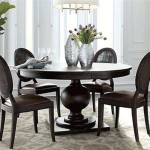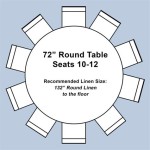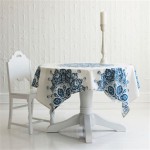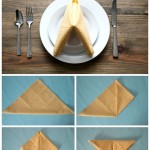Proper Use of Table Napkins in School: A Guide to Etiquette
Table manners constitute an integral part of social etiquette, encompassing a range of behaviors that contribute to a pleasant and respectful dining experience. Among these behaviors, the proper use of table napkins stands out as a fundamental skill, particularly relevant within the school environment. Mastering this skill not only enhances personal presentation but also demonstrates consideration for others and contributes to a more refined and organized learning atmosphere during meal times.
In educational settings, teaching and reinforcing proper table manners, including napkin etiquette, holds significant importance. School cafeterias and dining halls serve as crucial spaces for students to practice and internalize these social graces. By understanding and implementing the correct techniques for using table napkins, students develop confidence, demonstrate respect for their peers and educators, and cultivate a sense of decorum essential for navigating various social situations beyond the classroom.
This article aims to provide a comprehensive guide to the proper use of table napkins within the school context. It will outline the essential guidelines and best practices that students should follow to ensure they are using napkins effectively and appropriately, contributing to a more positive and dignified dining experience for everyone.
Placement and Initial Use of the Napkin
The initial act of handling the table napkin sets the tone for the entire meal. Upon being seated at the table, the first step involves locating the napkin. In a formal setting, the napkin may be placed to the left of the plate, beneath the silverware, or sometimes elegantly folded on the plate itself. In a more casual school cafeteria setting, napkins are often found in dispensers or placed directly on the tray.
Once the napkin is located, the immediate action is to unfold it. The manner in which the napkin is unfolded demonstrates a degree of awareness and finesse. The napkin should be unfolded discreetly without any exaggerated flourishes or loud snapping sounds. A gentle and controlled unfolding is considered the most appropriate approach.
The unfolded napkin should then be placed in the lap. This act serves several purposes. Firstly, it provides a protective barrier against accidental spills and crumbs, preventing stains and maintaining a tidy appearance. Secondly, it signals to others that the individual is ready to begin the meal and is attentive to maintaining proper etiquette.
The napkin should remain in the lap throughout the entire meal, unless there is a specific reason to remove it, such as dabbing at the mouth or fingers. When leaving the table temporarily, the napkin should be placed on the chair, indicating that the individual intends to return. It should never be placed on the table at this point, as this can be perceived as signaling the end of the meal.
Proper Techniques for Using the Napkin During the Meal
The primary function of the table napkin during a meal is to maintain cleanliness and hygiene. It is used to gently dab the mouth, wipe the fingers, and protect clothing from spills and stains. However, the manner in which these actions are performed is crucial to demonstrating proper etiquette.
When dabbing the mouth, the napkin should be lifted to the mouth and pressed gently. Avoid wiping or scrubbing the mouth forcefully, as this can be considered uncouth. A light, blotting motion is sufficient to remove any food particles or liquids.
Similarly, when wiping the fingers, the napkin should be used delicately. Avoid aggressively scrubbing the fingers or using excessive force. A gentle wipe is typically adequate to remove any residue. If the fingers are particularly soiled, it may be appropriate to excuse oneself and wash them at a restroom.
In the event of a spill, the napkin should be used immediately to blot the affected area. Avoid rubbing the spill, as this can spread the stain. A gentle blotting motion will help to absorb the liquid and minimize the damage. If the spill is significant, it may be appropriate to ask for assistance from a staff member or another student.
It is important to note that the table napkin is not intended to be used for purposes other than maintaining cleanliness during the meal. It should not be used to blow the nose, clean eyeglasses, or wipe utensils. These actions are considered inappropriate and unhygienic.
Additionally, the napkin should not be used to polish silverware. If silverware appears to be soiled, it is appropriate to request a clean set from a staff member. Using the napkin to polish silverware is considered unsanitary and ineffective.
Throughout the meal, the napkin should be kept relatively clean. Avoid allowing it to become excessively soiled with food debris. If the napkin becomes visibly dirty, it may be appropriate to request a fresh napkin from a staff member.
Concluding the Meal and Napkin Placement
At the conclusion of the meal, the manner in which the napkin is placed on the table communicates a specific message. The placement of the napkin signals that the individual has finished eating and is ready to leave the table. The correct placement of the napkin demonstrates respect for the host or staff and contributes to a more organized and aesthetically pleasing dining environment.
When the meal is finished, the napkin should be loosely folded and placed to the left of the plate. The napkin should not be crumpled or balled up, as this can be perceived as disrespectful. A simple, loose fold is sufficient to indicate that the meal is complete.
Avoid attempting to refold the napkin perfectly into its original shape. This is not necessary and can sometimes draw unnecessary attention. A simple, loose fold is the most appropriate and discreet approach.
The napkin should be placed on the table, not on the plate or in the chair. Placing the napkin on the plate can create an unsightly mess, while placing it in the chair can be unhygienic and uncomfortable for the next person who sits in the chair.
If the meal is being served in a self-service cafeteria where trays are used, the napkin should be placed on the tray along with the used dishes and utensils. This allows the staff to easily collect and dispose of the used items.
In some more formal settings, the host or hostess may indicate a specific place for napkin placement. In these cases, it is important to follow their instructions and place the napkin accordingly.
It is important to remember that the final placement of the napkin is a subtle but significant gesture that communicates respect and awareness of social etiquette. By following these guidelines, students can demonstrate their understanding of proper table manners and contribute to a more positive and dignified dining experience for everyone.
In conclusion, mastering the proper use of table napkins is a vital skill for students in the school environment. By understanding and implementing these guidelines, students can enhance their personal presentation, demonstrate respect for others, and cultivate a sense of decorum that will serve them well in various social situations throughout their lives. From the initial placement to the final gesture, each aspect contributes to a more refined and organized learning atmosphere during meal times.

8 Ways To Use A Napkin With Proper Table Etiquette Wikihow

27 Napkin Fold Ideas

8 Ways To Use A Napkin With Proper Table Etiquette Wikihow

8 Ways To Use A Napkin With Proper Table Etiquette Wikihow

Table Etiquette The Place Setting Rooted In Foods

Table Etiquette The Place Setting Rooted In Foods

How To Set A Table For Casual And Formal Dining

How To Fold A Napkin For Table Setting

Benefits Of Using Table Napkins Efavormart Com

How To Fold A Napkin 11 Ways The Home Depot
Related Posts

